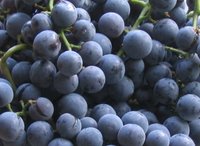Today I realized that tomorrow is Halloween. It won’t make much difference, since Halloween doesn’t seem to be celebrated here at all. An elementary Sunday school class from Dave’s home church sent us a cute handmade jack-o-lantern wall hanging, which we promptly hung on our apartment door. That will probably be the extent of our Halloween celebration. Even if we wanted to, carving jack-o-lanterns would be difficult, since I’ve never seen an actual orange, round pumpkin as we know them back home. Most of what I use as “pumpkin” for cooking is butternut or other kinds of squash. In Russian, all winter squash, including pumpkin, is called the same thing – tikva.
But even though Halloween is not commonly celebrated here, it might have a future, thanks to Amstor, the local supermarket. Today I went to Amstor for a few things, and pumpkin was on my list. As I reached the produce section, I noticed a bin with a bunch of round, cellophane-wrapped objects, and above them a display a large sign that said “Halloween” in English. Upon further inspection, I realized that the round objects, though they were a greenish-gray mottled color, were pumpkins. And they had mean-looking, jagged-featured carved faces. Underneath the sign was an explanation of Halloween and jack-o-lanterns (translated into Russian as “pumpkin heads”). The sign, in addition to explaining the history of Halloween and the purpose of jack-o-lanterns, said Halloween was celebrated all over the world, which was an interesting statement, since if it really was celebrated here, they wouldn’t need a sign to explain the holiday and persuade customers to buy pre-carved pumpkins. Maybe its celebrated everywhere but Ukraine. Or maybe the Soviets nixed it – the bad spirit world could have been just as threatening as the good one. Anyway, after the initial “cultural moment,” I was sad to find that the carved pumpkins were the only ones to be found in the produce section, save three gigantic squashes that would, if stood on end, reach above my knee. Not good for bus travel. So I left without a pumpkin or a pumpkin head. I’d like to go back to Amstor in early November and see how many have sold.




